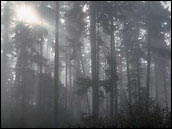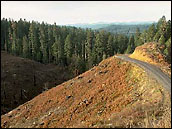| "These old forests in the Pacific Northwest were thought to be
of little value to anyone but loggers not more than thirty years ago.
People were simply unaware that the spotted owls were out there,"
said Eric Forsman, a research wildlife biologist with the United States
Forest Service. Forsman’s graduate work in 1972 is part of the
reason people are aware of the owls today. He and researchers at Oregon
State University discovered that a majority of spotted owls reside in
old areas of the forest where the trees are typically more than 100
years old.
Spotted owls evolved over eons to thrive in the old-growth conifer
forests. Forsman said everything about their lives depends on these
types of forests. They build their nests in large tree cavities and on
thick branches in dense tree canopies. The owls hunt for animals found
in abundance in the decaying logs and leaves of the old forest. They
even developed coloring that camouflages them in the shadows created by
the big trees. When the old forest is chopped down, the birds have
trouble nesting and feeding their young, Forsman said.
|
|

The predominant ecosystem in the Pacific
Northwest is temperate rain forest. Mature forests are characterized by a full range of
tree ages, from saplings to decomposing logs. This diversity in age results in a
complex canopy and a layer of detritus on the forest floor. (Photograph courtesy U.S Fish and Wildlife Service) |
| By the early 1970s, logging companies had already reduced the old
forest in the Pacific Northwest by 85 to 90 percent. "After making
the discovery about the owls, we looked at the area planned for harvest
by logging companies in the future and noticed that a majority of it was
the remaining old forest - spotted owl habitat," said Forsman.
"Fifty percent of the area belonged to the government."
Over the next decade news of the owl’s plight spread. Eventually
concern for the owl caught the attention of the media and mainstream
environmental groups. Clashes erupted between environmentalists and
loggers, whose livelihood was being threatened. The northern spotted owl
practically became the mascot for the environmental movement in this
country. Extremist groups even tied themselves to marked trees and
damaged logging equipment. "I was amazed to see how the pendulum
had swung. It got to the point where you couldn’t even go into the
woods to cut down so much as one tree," said Forsman.
The U. S. Fish and Wildlife Service made the concern for the northern
spotted owl official in 1990 when they placed the bird on the Federal
Threatened Species List. Little was done about the owls until a year
after President Clinton took office. His administration established the
Forest Ecosystem Management Team (FEMAT) in 1993. The team was made up
of personnel from the Bureau of Land Management (BLM), the United States
Forest Service (USFS), the U. S. Fish and Wildlife Service (USFWS), and
regional universities (U.S. Fish and Wildlife Service, 1996).
Together they drew up a plan that reduced future timber harvests on
federal property by 80 percent and created a number of guidelines to
manage the remaining older forest. One of the primary goals of the plan
was to develop a model to determine the well being of spotted owls and
their habitat, strewn out across 25 million acres of land in western
Oregon, Washington, and Northern California (Bureau of Land Management,
1993).
  The Problem with Spotting Owls The Problem with Spotting Owls
 Spotting the Spotted Owl Spotting the Spotted Owl
|

A cheap and effective method of harvesting
lumber is to clearcut. Unfortunately, clearcutting destroys the diversity of the forest,
leaving habitat unsuitable for the spotted owl even after decades of regrowth.(Photograph courtesy U.S Fish and Wildlife Service) |

